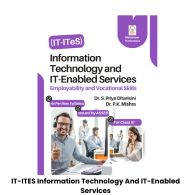

Engineering Economics & Accountancy
Inhouse product
-
Rs212.50
Rs250.00 -
Rs254.15
Rs299.00 -
Rs288.00
Rs300.00 -
Rs276.25
Rs325.00 -
Rs175.50
Rs195.00 -
Rs238.00
Rs280.00
Reviews & Ratings
Engineering Economics & Accountancy by Rishi Bhargav Das and Dr. Jagat Jyoti Barua is a comprehensive and practice-oriented textbook tailored to the latest syllabus prescribed by the Directorate of Technical Education (DTE) for diploma and technical courses. The book equips engineering students with essential knowledge of economic principles and accounting practices necessary for effective decision-making in technical and industrial environments.
The text combines economics, finance, costing, and accounting fundamentals to bridge the gap between engineering and management. Written in simple, student-friendly language, it helps learners develop an understanding of how economic feasibility, costing, budgeting, and financial statements influence engineering decisions and project planning.
Chapter 1: Introduction to Economics
-
Definitions & nature of economics
-
Microeconomics vs. macroeconomics
-
Utility concepts (Cardinal & Ordinal)
-
Law of Diminishing Marginal Utility
-
Value, exchange, and the Water–Diamond Paradox
-
National Income: concepts, measurement, APS, MPC
-
E-commerce: meaning, benefits, and issues
Chapter 2: Demand and Supply
-
Demand meaning & types
-
Demand function
-
Elasticity of demand
-
Law of demand & exceptions
-
Market demand
-
Supply, determinants, and elasticity
-
Individual & market supply curves
Chapter 3: Production
-
Factors of production
-
Labour efficiency
-
Capital formation
-
Localization of industries
-
Large-scale & small-scale industries (with special reference to Assam)
-
Economies of scale & scope
-
Industrial prospects in Assam
Chapter 4: Money
-
Nature and evolution of money
-
Qualities of good money
-
Money supply measures
-
Gresham’s Law
-
Types and functions of money
-
Value of money & changes in value
Chapter 5: Banking Organisations
-
Banking system overview
-
Central Bank: functions, credit control
-
Commercial banks: origin, functions
-
Internet banking: features & advantages
Chapter 6: Market
-
Meaning & types of market
-
Perfect competition, monopoly, oligopoly, monopolistic competition
-
Pricing policies
-
Price-setting & price discrimination
-
Market strategies
Each chapter ends with Questions for Review to reinforce learning.
? PART B – Accountancy (Chapters 7–12)
Provides essential knowledge for understanding, recording, and analyzing financial transactions.
Chapter 7(A): Introduction to Bookkeeping & Accountancy
-
Concepts of accounting
-
Objectives and functions
-
Types of accounts
Chapter 7(B): Computerized Accounting System
-
Basics of digital accounting
-
Advantages of computerized systems
Chapter 8: Transactions
-
Journal entries
-
Recording rules
Chapter 9: Journal and Ledger
-
Posting entries
-
Balancing accounts
Chapter 10: Cash Book
-
Single, double, and three-column cash books
-
Petty cash book
Chapter 11: Trial Balance & Errors in Accounting
-
Methods of preparing trial balance
-
Types of accounting errors
Chapter 12: Preparation of Final Accounts
-
Trading Account
-
Profit & Loss Account
-
Balance Sheet
Frequently Bought Products
Product Queries (0)
Login Or Registerto submit your questions to seller
Other Questions
No none asked to seller yet
-
Rs212.50
Rs250.00 -
Rs254.15
Rs299.00 -
Rs288.00
Rs300.00 -
Rs276.25
Rs325.00 -
Rs175.50
Rs195.00 -
Rs238.00
Rs280.00







